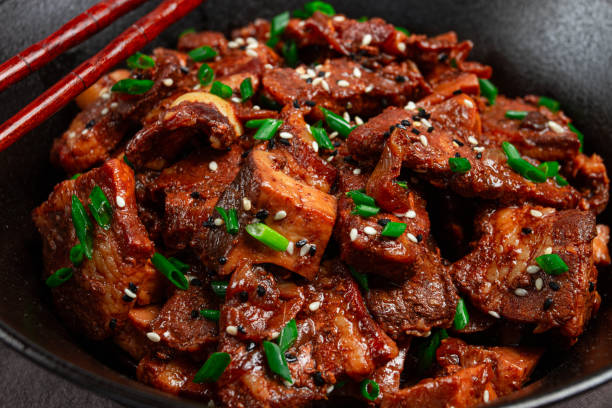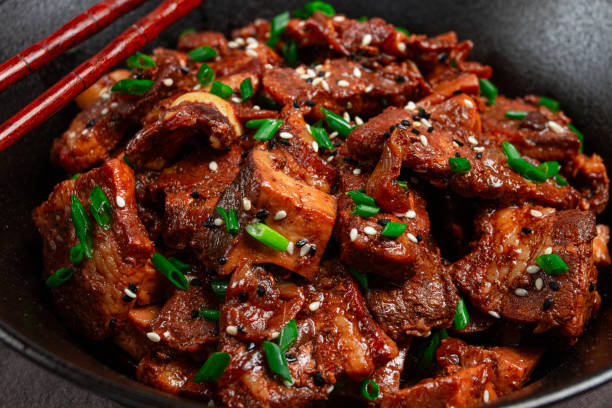Bulgogi sauce is a tasty Korean sauce that you can use as a marinade or a cooking sauce. It smell sweet, salty, and really rich, so even the cheapest beef or veggies taste fancy. When you grill or stir-fry meat with it, the sauce gives everything a shiny glaze and keeps it juicy and tender. People in Korea and all around love this sauce for the big boost of flavor it gives to simple dishes.
In Korean cooking, Bulgogi sauce is super important. It shows off the main tastes that Koreans like and it fits into old and new recipes. You can use it for bulgogi, of course, but also for grilled chicken, pork, or even stir-fried veggies. This guide will dive into how Bulgogi sauce was first made, why it matters, what’s in it, and how to use it, so you can try making it at home.

The History of Bulgogi Sauce
People say bulgogi started in the 17th century in Korea. Back then it was called “neobiani,” wich means “thinly spread meat.” Only royal families ate it at big events. They would slice beef real thin and soak it in sauce made of soy sauce, sugar, and spices to make the flavors pop. That showed off how fancy cooking was at the king’s court.
As time went on, regular folks wanted a taste too. The recipe changed a bit to fit everyday life. Now bulgogi isn’t just beef—it can be chicken, pork, or even tofu and mushrooms for vegetarians. And you don’t need a huge grill; you can pan-fry or stir-fry it at home. Today it’s a huge part of Korean BBQ and people all over the world love it for how easy and flavorful it is.
Ingredients in Bulgogi Sauce
The core of Bulgogi sauce comes from a few simple stuffs:
- Soy Sauce: Gives salt and deep color to the sauce.
- Sugar (or Honey): Adds sweetness to balance the saltiness.
- Sesame Oil: Brings a nutty smell and taste.
- Garlic and Ginger: Give warmth and depth, they’re a must.
- Pepper (Black or Red): A little spice to round out the flavors.
People also mix in other things to make it special. Some add pear or apple puree so the meat is sweeter and softer. Others use gochujang (Korean red chili paste) if they want a kick. These tweaks show how flexible Bulgarian sauce can be, and how many tastes are in Korean food.

How to Make Bulgogi Sauce
Making Bulgogi sauce at home is pretty easy and you can tweak it to your taste. Below is a simple recipe that most people can follow.
Ingredients List
- Soy sauce: ½ cup
- Brown sugar: 3 tablespoons
- Sesame oil: 2 tablespoons
- Minced garlic: 4 cloves
- Grated ginger: 1 tablespoon
- Ground black pepper: 1 teaspoon
- Optional: pear juice for sweetening and flavor
Directions
- Put the soy sauce, brown sugar, sesame oil, garlic, ginger, and pepper into a bowl.
- Whisk it all up until the sugar is pretty much gone and it looks smooth.
- Taste it. If it’s too salty, add more sugar. If it’s too sweet, add a bit more soy sauce.
- If you want, pour in some pear juice so the meat gets softer when you marinate.
- Keep the sauce in a sealed jar in the fridge for up to one week.
Tips for Best Results
- Use fresh garlic and ginger, they give better flavour.
- Let the sauce sit for a few hours or overnight before using so tastes can mingle.
- Make sure your meat or veggies are covered in sauce when you marinate.
How to Use Bulgogi Sauce
Marinating and Cooking Techniques
When you marinate beef or anything else:
- Choose cuts that soak up flavor, like ribeye, sirloin, or flank steak.
- Marinate for at least 30 minutes. For extra taste, leave it in the fridge for several hours or overnight.
Cooking Methods
You can cook bulgogi many ways:
- Grilling: Best if you want that smoky taste. Cook over high heat until it’s nicely charred.
- Stir-frying: Use a hot pan or wok for quick, tasty meat.
- Pan-frying: Add oil to a skillet and brown the meat, then serve with veggies.
Pairing with Vegetables and Side Dishes
Bulgogi sauce goes great with sides:
- Grilled veggies like zucchini, bell peppers, and mushrooms.
- Steamed rice to soak up the sauce.
- Kimchi for a spicy, tangy boost.
Health Considerations
Nutritional Value
Bulgogi sauce is low in calories but can pack a lot of salt because of the soy sauce. A typical serving has:
- Sodium: 500-700 mg
- Sugars: Depends on your sweetener
Healthier Alternatives
- Low-sodium soy sauce: Cuts down on salt without losing flavor.
- Organic sweeteners: Try agave syrup or coconut sugar instead of brown sugar.
Storage and Shelf Life
How to Store Bulgogi Sauce
- Keep it in a airtight jar so it does’nt absorb other smells.
- Refrigerate and it will last for up to a week.
Tips on Extending Shelf Life
You can freeze extra sauce in ice cube trays, then move the cubes to a freezer bag. Thaw in the fridge before you use it again.
FAQs about Bulgogi Sauce
What is the difference between Bulgogi sauce and marinade?
Bulgogi sauce is a special marinade for bulgogi, but you can also use it as a cooking sauce after you marinate your food.
Can I use Bulgogi sauce for dishes other than beef?
Yes! It’s great on chicken, pork, other meats, and even veggies, adding extra flavor every time.
How do you make Bulgogi sauce less salty?
Choose low-sodium soy sauce and throw in more sweet stuff like fruit purees or sugar.
Can I make Bulgogi sauce vegan or vegetarian?
Sure, use vegetable broth instead of soy sauce and add a bit of miso to get depth of flavor.
How long can I marinate meat in Bulgogi sauce?
Marinate from 30 minutes up to 24 hours. Don’t go past a day or the meat might get too soft or mushy.
Conclusion
Bulgogi sauce is a flavor-packed addition to any cook’s kitchen. It’s simple to make and works on lots of dishes, so give it a try and see how it turns your meals from normal to awesome!

Bulgogi Sauce (Korean BBQ Beef Sauce)
Equipment
- 1 mixing bowl
- 1 whisk or spoon
- 1 set measuring cups and spoons
- 1 airtight container for storage
Ingredients
- ½ cup soy sauce
- ¼ cup brown sugar
- 2 tablespoons sesame oil
- 2 tablespoons rice vinegar
- 4 cloves garlic, minced
- 1 tablespoon ginger, minced
- 1 tablespoon gochugaru (Korean red pepper flakes) Increase for spiciness if desired.
- 1 tablespoon sesame seeds
- ½ teaspoon black pepper
- 4 pieces green onions, finely chopped
Instructions
- In a mixing bowl, combine the soy sauce and brown sugar. Stir until the sugar is dissolved.
- Add in the sesame oil, rice vinegar, minced garlic, and minced ginger. Whisk together until well blended.
- Stir in the gochugaru, sesame seeds, black pepper, and chopped green onions. Mix until all ingredients are evenly incorporated.
- Taste the sauce and adjust the seasoning if necessary by adding more sugar for sweetness or soy sauce for saltiness.
- Use immediately with thinly sliced beef or store in an airtight container in the refrigerator for up to one week.





Leave a Reply